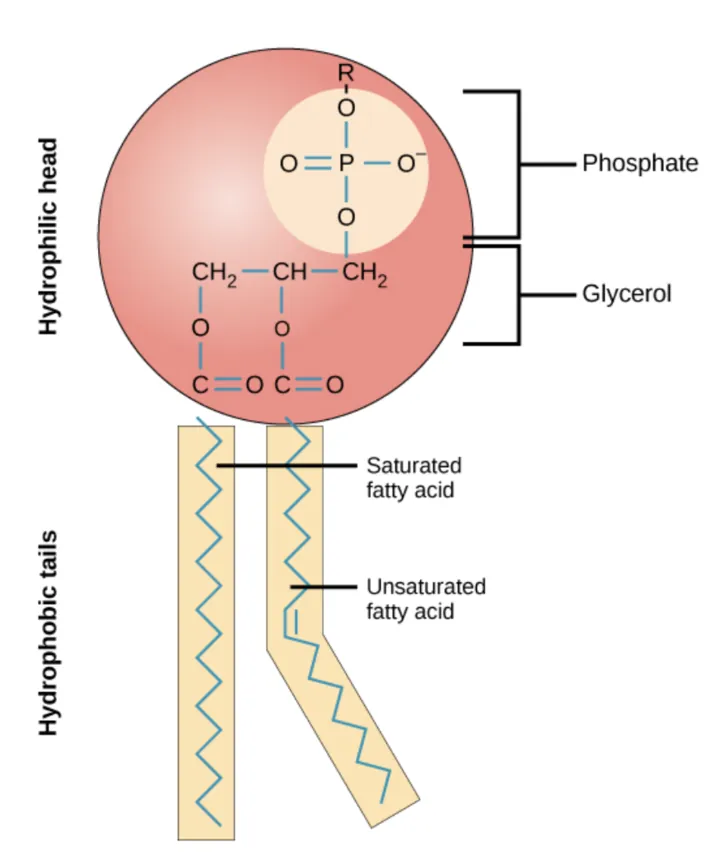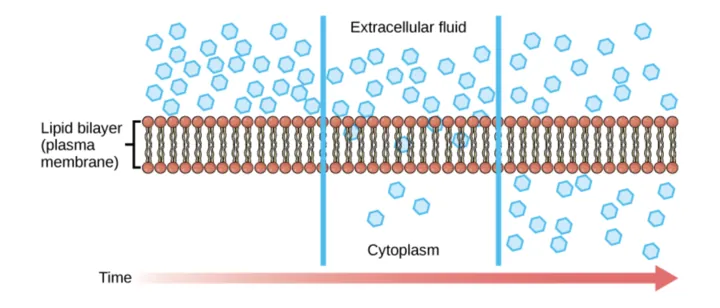1
.
Which plasma membrane component can be either found on its surface or embedded in the membrane structure?
-
carbohydrates
-
cholesterol
-
glycolipid
-
protein
2
.
In addition to a plasma membrane, a eukaryotic cell has organelles, such as mitochondria, that also have membranes. In which way would these membranes differ?
-
The proportion of phosphate within the phospholipids will vary.
-
Only certain membranes contain phospholipids.
-
Only certain membranes are selectively permeable.
-
The proportions of proteins, lipids, and carbohydrates will vary.
3
.
Which characteristic of a phospholipid, shown here, increases the fluidity of the membrane?

-
cholesterol
-
its head
-
saturated fatty acid tail
-
double bonds in the fatty acid tail
4
.
How would an organism maintain membrane fluidity in an environment where temperatures fluctuated from very high to very low?
-
Greater proportion of unsaturated phospholipids in membranes.
-
Greater proportion of saturated phospholipids in membranes.
-
Greater proportion of carbohydrates in membranes.
-
Greater proportion of proteins in membranes.
5
.
According to the fluid mosaic model of the plasma cell membrane, what is the location of carbohydrates in the cell membranes?
-
Carbohydrates are in contact with the aqueous fluid both inside and outside the cell.
-
Carbohydrates are present only on the interior surface of a membrane.
-
Carbohydrates are present only on the exterior surface of a membrane.
-
Carbohydates span only the interior of a membrane.
6
.
What do double bonds in phospholipid fatty acid tails contribute to?

-
the fluidity of membranes
-
the hydrophobic nature of membranes
-
the hydrophilic nature of membranes
-
preventing high temperatures from increasing fluidity of membranes
7
.
Identify the principal driving movement in diffusion, such as depicted here.

-
concentration gradient
-
membrane surface area
-
particle size
-
temperature
8
.
Which of the following is an example of passive transport across a membrane?
-
the movement of into a thylakoid disc during photosynthesis
-
the uptake of glucose in the intestine
-
the uptake of mineral ions into root hair cells of plants
-
the movement of water from the descending loop of a nephron into the interstitium
9
.
Water moves via osmosis across plasma cell membranes in which direction?
-
from an area with a high concentration of other solutes to a lower one
-
from an area with a high concentration of water to one of lower concentration
-
from an area with a low concentration of water to one of higher concentration.
-
throughout the cytoplasm
10
.
What problem is faced by organisms that live in fresh water?
-
They will have higher concentrations of body solutes.
-
Without compensating mechanisms, their bodies tend to take in too much water.
-
They have no way of controlling their tonicity.
-
Their bodies tend to lose too much water to their environment.
11.
Which of the following questions can be asked about organisms that live in fresh water?
- Will their bodies take in too much water?
- Can they control their tonicity?
- Can they survive in salt water?
- Will their bodies lose too much water to their environment?
12.
Why must active movement of molecules across membranes function continuously?
13
.
Why must active transport of molecules across plasma membranes function continuously?
-
Diffusion cannot occur in certain cells.
-
Diffusion is constantly moving solutes in opposite directions.
-
Facilitated diffusion works in the same direction as active transport.
-
Not all membranes are amphiphilic.
14
.
How does the sodium-potassium pump make the interior of the cell negatively charged?
-
by expelling anions
-
by pulling in anions
-
by expelling more cations than it takes in
-
by taking in and expelling an equal number of cations
15
.
What is the difference between primary and secondary active transport?
-
Primary active transport is indirectly dependent on ATP, while secondary active transport is directly dependent on ATP.
-
Primary active transport is directly dependent on ATP, while secondary active transport is indirectly dependent on ATP.
-
Primary active transport does not require ATP, while secondary active transport is indirectly dependent on ATP.
-
Primary active transport is indirectly dependent on ATP, while secondary active transport does not require ATP
16
.
What happens to the membrane of a vesicle after exocytosis?
-
It leaves the cell.
-
It is disassembled by the cell.
-
It fuses with and becomes part of the plasma membrane.
-
It is used again in another exocytosis event.
17
.
In what important way does receptor-mediated endocytosis differ from phagocytosis?
-
It transports only small amounts of fluid.
-
It does not involve the pinching off of membrane.
-
It brings in only a specifically targeted substance.
-
It brings substances into the cell, while phagocytosis removes substances.
